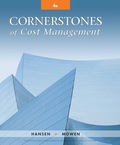
Concept explainers
For each of the following independent situations, calculate the missing values:
- 1. The Belen plant purchased $78,300 of direct materials during June. Beginning direct materials inventory was $2,500, and direct materials used in production were $73,500. What is ending direct materials inventory?
- 2. Forster Company produced 14,000 units at an average cost of $5.90 each. The beginning inventory of finished goods was $3,422. (The average unit cost was $5.90.) Forster sold 14,120 units. How many units remain in ending finished goods inventory?
- 3. Beginning work in process (WIP) was $116,000, and ending WIP was $117,300. If total
manufacturing costs were $349,000, what was the cost of goods manufactured? - 4. If the conversion cost is $84 per unit, the prime cost is $55, and the manufacturing cost per unit is $105, what is the direct materials cost per unit?
- 5. Total manufacturing costs for August were $412,000. Prime cost was $64,000, and beginning WIP was $76,000. The cost of goods manufactured was $434,000. Calculate the cost of
overhead for August and the cost of ending WIP.
1.
Calculate the ending direct materials inventory.
Explanation of Solution
Materials Inventory:
- Materials inventory comprises of the direct material costs, and indirect material costs.
- The balance in the materials inventory at the end of the accounting period represents the inventories that have not entered into the process of manufacturing.
Calculate the ending direct materials inventory.
Thus, the amount of ending direct materials inventory is $7,300.
2.
Calculate the ending finished goods inventory.
Explanation of Solution
Finished goods Inventory:
- Finished goods inventory comprises of the finished products.
- The balance in the materials inventory at the end of the accounting period represents the inventories that are completed manufacturing, but have not been sold.
Calculate the ending finished goods inventory.
Thus, the ending finished goods inventory is 460.
Working note (1):
Calculate the beginning finished goods inventory.
3.
Calculate the cost of goods manufactured.
Explanation of Solution
Cost of goods manufactured: Cost of goods manufactured refers to the cost incurred for a making a product, that are available for sales at the end of the accounting period.
Calculate the cost of goods manufactured.
Thus, the amount of cost of goods manufactured is $347,700.
4.
Calculate the direct material cost per unit.
Explanation of Solution
Direct material cost: A cost indicates the payment of cash or the obligation to pay the cash in the future period for the generation of revenue or the service performed. A direct material cost is the cost of raw materials used for producing a product. For example: The cost of plastic is the direct material for manufacturing a bottle.
Prime cost: Prime cost refers to a cost which is directly involved in the process of manufacturing an item. Prime cost includes direct material, and direct labor costs.
Conversion cost: A conversion cost refers to the cost of converting the raw materials into a finished product. Conversion cost includes direct labor as well as factory overhead costs.
Manufacturing costs: Manufacturing costs are the costs which are involved in converting the raw materials into the finished products.
Calculate the direct material cost per unit.
Working note (2):
Step 1:
Determine the direct materials by using the prime cost.
Step 2:
Determine the overhead by using the conversion cost.
Step 3:
Determine the direct labor by using Step (1) and Step (2)
5.
Calculate the overhead cost and cost of ending work in process.
Explanation of Solution
Work in process Inventory: Work in process inventory comprises of the direct material costs, direct labor costs, and factory overhead costs that have entered into the process of manufacturing, but are not yet completed.
Calculate the overhead cost.
Thus, the overhead cost is $348,000.
Calculate the cost of ending work in process.
Thus, the ending work in process is $54,000.
Want to see more full solutions like this?
Chapter 2 Solutions
EBK CORNERSTONES OF COST MANAGEMENT
- What is the total period cost under variable costing?arrow_forwardSubject: Financial Accounting-The Banner Income Fund's average daily total assets were $100 million for the year just completed. Its stock purchases for the year were $20 million, while its sales were $12.5 million. What was its turnover?arrow_forwardSubject: Financial Accounting-The Banner Income Fund's average daily total assets were $100 million for the year just completed. Its stock purchases for the year were $20 million, while its sales were $12.5 million. What was its turnover? No AI ANSWERarrow_forward
- Accurate answerarrow_forwardI don't need ai answer general accounting questionarrow_forwardWhat specifies the accounting for multi-year insurance policies paid in advance? (a) Expense total premium immediately (b) Record as asset and amortize systematically (c) Recognize when coverage provided (d) Split between years equallyarrow_forward
 Cornerstones of Cost Management (Cornerstones Ser...AccountingISBN:9781305970663Author:Don R. Hansen, Maryanne M. MowenPublisher:Cengage Learning
Cornerstones of Cost Management (Cornerstones Ser...AccountingISBN:9781305970663Author:Don R. Hansen, Maryanne M. MowenPublisher:Cengage Learning College Accounting, Chapters 1-27AccountingISBN:9781337794756Author:HEINTZ, James A.Publisher:Cengage Learning,Principles of Accounting Volume 2AccountingISBN:9781947172609Author:OpenStaxPublisher:OpenStax College
College Accounting, Chapters 1-27AccountingISBN:9781337794756Author:HEINTZ, James A.Publisher:Cengage Learning,Principles of Accounting Volume 2AccountingISBN:9781947172609Author:OpenStaxPublisher:OpenStax College Managerial AccountingAccountingISBN:9781337912020Author:Carl Warren, Ph.d. Cma William B. TaylerPublisher:South-Western College Pub
Managerial AccountingAccountingISBN:9781337912020Author:Carl Warren, Ph.d. Cma William B. TaylerPublisher:South-Western College Pub Financial And Managerial AccountingAccountingISBN:9781337902663Author:WARREN, Carl S.Publisher:Cengage Learning,
Financial And Managerial AccountingAccountingISBN:9781337902663Author:WARREN, Carl S.Publisher:Cengage Learning, Managerial Accounting: The Cornerstone of Busines...AccountingISBN:9781337115773Author:Maryanne M. Mowen, Don R. Hansen, Dan L. HeitgerPublisher:Cengage Learning
Managerial Accounting: The Cornerstone of Busines...AccountingISBN:9781337115773Author:Maryanne M. Mowen, Don R. Hansen, Dan L. HeitgerPublisher:Cengage Learning





